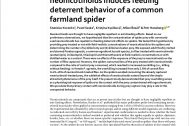Obsah
Neonicotinoids are thought to have negligible repellent or anti-feeding effects. Based on our preliminary observations, we hypothesized that the contamination of spider prey with commonly used neonicotinoids has repellent or feeding deterrent effects on spiders. We tested this hypothesis by providing prey treated or not with field-realistic concentrations of neonicotinoids to the spiders and determining the number of (a) killed only and (b) killed and eaten prey. We exposed adult freshly molted and starved Pardosa agrestis, a common agrobiont lycosid species, to flies treated with neonicotinoids (acetamiprid, imidacloprid, thiacloprid and thiamethoxam) at field-realistic concentrations or with distilled water as a control. There were no effects of the exposure of the prey to neonicotinoids on the number of flies captured. However, the spiders consumed less of the prey treated with neonicotinoids compared to the ratio of control prey consumed, which resulted in increased overkilling (i.e., killing
without feeding). In female P. agrestis, the overkilling increased from only 2.6% of control flies to 25–45% of neonicotinoid-treated flies. As the spiders avoided consuming the already captured neonicotinoid-treated prey, the sublethal effects of neonicotinoids extend beyond the simple attractivity/deterrence of the prey itself. The present study demonstrated that prey overkilling serves as a physiological response of spiders to the contact with the prey contaminated with agrochemicals. We speculate that primary contact with neonicotinoids during prey capture may play a role in this unexpected behavior.
without feeding). In female P. agrestis, the overkilling increased from only 2.6% of control flies to 25–45% of neonicotinoid-treated flies. As the spiders avoided consuming the already captured neonicotinoid-treated prey, the sublethal effects of neonicotinoids extend beyond the simple attractivity/deterrence of the prey itself. The present study demonstrated that prey overkilling serves as a physiological response of spiders to the contact with the prey contaminated with agrochemicals. We speculate that primary contact with neonicotinoids during prey capture may play a role in this unexpected behavior.



